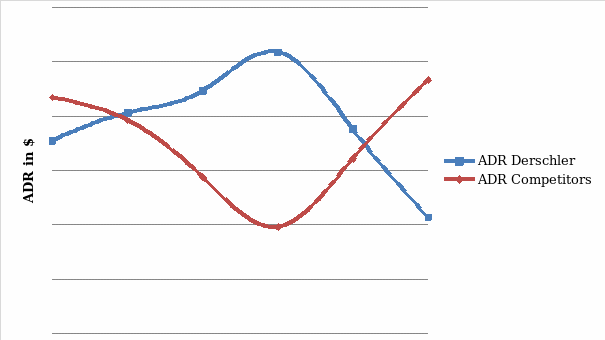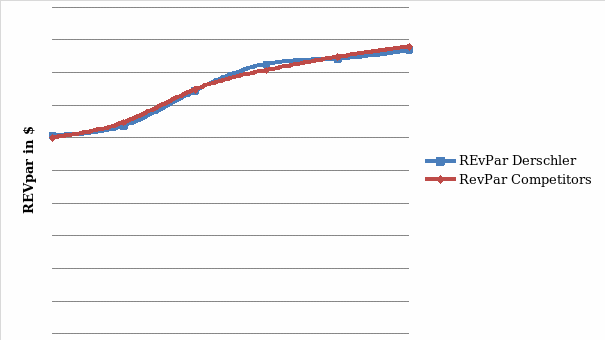Introduction and Background
The hospitality industry is generally a very competitive business. Taking a look at the lodging sector in such industry, it can be seen that with more than 47,000 hotels in the United States and more than 4.4 million guest rooms, the business is highly fragmented, where the differentiation in hotel’s types and rating systems does not prevent the industry from being a $113.7 billion business. In that regard, one of the main concerns of such an industry is the problem of forecasting, anticipating what is to come and assessing profit to predicted values. In that regard, many hotels employ industry averages and the indicators of the nearest competition as points of comparison, assessing the company’s developments and achievements. Although it is argued that the implementation of such comparisons might be misleading, it often can be used as an indicator of potential financial troubles, and a driving force for improvements and innovations.
In the light of the aforementioned, the Drechsler Hotel can be seen in a similar position. The Drechsler Hotel, Tubac, Arizona, is a Hotel located 39 miles south of Tucson. The hotel offers thirty guest rooms, located steps away from the Santa Cruz River. Despite the fact that the hotel’s indicators such as occupancy levels and revenues were higher than the last years, these figures were lower than the projected numbers. Combined with an increase in the total costs of running the hotel, such fact was a major concern for hotel’s owners. In that regard, this paper provides an overview of the case of the Drechsler Hotel, providing recommendations on potential improvements that will prevent the owners from filing for bankruptcy.
Competition and Performance
The main source of performance assessment used by the management of the Drechsler Hotel is the Average Daily Rate (ADR) and Revenue per Available Room (Revpar). Both the Occupancy and the ADR generally show an upward trend, if considered separately without focusing on the position of the competition. Accordingly, the changes might be seasonal, as the trends do not show the numbers for the whole year. Taking the acceptable average for the industry for the first quarter of 2010, the occupancy rates have an average of 51.9, considering a 2.3 percent increase from the previous period (STR, 2010). In that regard, the occupancy rates, which can be seen from Appendix 1, indicate that rates fall within the industry’s average. Moreover, comparing the six months period in the graph with the industry’s average, it can be seen that the lowest points in the trend are still higher than the average, and at the same time the average for the period, (Appendix 4), is also higher, although slightly lower than that of the competitors.
The same can be said about ADR, where despite the fact in December, the rate reached its lowest point in six months (Appendix 2), this point conforms to the average of the industry in the first quarter in 2010, US$96.27 (STR, 2010). The average and the median, is nevertheless, higher than those of the competitors, which is $103, 82 and $103, 14 respectively. In that regard, although both indicators when taking independently are not representative of sales performance (Guilding, 2002, p. 75), they do not show distinctly negative results, with the exception of the downward trend of ADR for the last 3 months. Revpar rates, which are considered as complementary to the incompleteness provided by ADR and occupancy, might give a better picture of the financial position, combining both the aforementioned indicators. As it might be seen from Appendix 3, there is also an upward trend, which is going toe-to-toe with the competition, and at the same time higher than the average of the industry, which constitutes US$50.01 (STR, 2010), against the average of $75,34 and a median of $78,40 for the Drechsler Hotel.
The statement by owners that the indicators of the hotel are declining can stem from the fact that the total daily room revenue is low, compared with the predicted numbers and considering the increasing expenditures. Total daily room revenue is approximately $2261, 7, with a difference of $849, 3 for a day in potential revenues. Accordingly, one of the issues that can be identified in this case is the high costs of managing the hotels as compared to its revenues. Another issue can be seen in the fact that the Revpar is calculated on a per room basis, and thus, despite having a relatively equal Revpar with that of competitors, the low number of rooms-30, lead to low revenues. Thus, the issues can be summarized as low rooms number and relatively high expenditures of offering the service to customers.
Proposed Improvements
With Revpar being considered as the ultimate performance measurement, the key to increasing the revenues of the hotel can be seen in increasing the Revpar measure. One potential improvement to the hotel can be seen through the implementation of a system of online reservation. Calculating Revpar, the intermediary chain is not taken into consideration, and thus, increasing direct sales through own website can be seen as a beneficial improvement to the management system in the hotel. Increasing the direct sales through the internet can be a suitable solution through which the expenditures and the commissions of intermediary channels can be reduced, as “web-based internet sales can compensate for what has not been sold in advance to fill your hotel” (m-Travel, 2009).
Managing a system of reservation might enable to hotel to maintain records of costs and profits in advance and better predict the performance of the company more accurately. Accordingly, managing such reservations online will gain the company an advantage over their competitors, where “increasing your hotel’s online visibility, managing complicated internet opaque channels, and having the perfect competitive rate always listed on your website while keeping rate parity and best rate guarantee, will lead to a substantial increase in sales” (m-Travel, 2009).
The second option can be seen in maintain other sources of revenues other than the rooms themselves, including food and beverages options, restaurants, etc, which in the case of the Drechsler Hotel other options might be added as managing tours to the village, the rental of swimming and camping equipment for trips to the Santa Cruz River and etc. Such options will enable the Hotel to increase its assets while keeping the liabilities fixed, and at the same time offering new services might enable the company to differentiate their offers through providing different packages for different segments of the population and accordingly differentiate their prices more flexibly.
Funding Options
Among the available funding options for the Dreschler hotel bank loans can be seen as the most apparent. Conducting a detailed business plan and calculating the costs needed to finance the improvement will help the company to estimate the terms on which such loan will be made possible. Considering the absence of a working capital, such scheme can be seen appropriate, although it might be varied to include similar options, such attracting new investors or forming a partnership with sponsors from the local community, for whom the attraction of visitors will be mutually beneficial (Russell & Jamieson, 2008, p. 90).
Among other financing options that the hotel might consider is the changing the form of the property into timeshare, condominium, or mixed-use residents. Such conversion might imply a different form of business, with its own advantages and disadvantages. Taking the example of a timeshare, an important advantage of converting the hotel to such form can be seen in increasing the occupancy of the Drechsler Hotel. In that regard, finding 1500 residents (50 weeks x 30 rooms), will not be an issue. Accordingly, as soon as an owner was found for a certain week it serves as guarantee for future profit during the year through the same period. In that regard, such a market has its own demand, and considering the location of the Dreschler Hotel, such demand will persist in case of a successful conversion.
Another major advantage of converting the hotel into a timeshare can be seen through the capitalization of synergy profits. The latter can be explained through the provided possibility to generate sales from providing loans to the customers, and the activities on which the owners of the shares will spend money separately, and which were already indicated as options, such as the camping and swimming equipment rentals, the food and the beverages sector, the restaurant sector, and others.
The major disadvantage can be seen in the lengthy sale cycle for the timeshares (Gose, 2003). It might take a long time until all room/weeks are sold completely, considering that several of those room/weeks will have a lower demand. The latter might be explained by the preferences for specific seasons of vacations. In that regard, it might take a long time until the conversion will be completed. During such period many consumers might “rescind their decision to buy… [or] default on developer-provided financing” (Gose, 2003).
Thus, it can be stated that the provided options of improvement can be integrated into the plan of conversion, with the exception of changing the online reservation system of the Drechsler Hotel into a marketing and promotional tool for the timeshare and accordingly into an agency for sales. In that regard, the name of the hotel might be changed to represent the new direction of the business. The proposed name will be the Drechsler Owners Club, which reflects the new connection of the customers to the business as owners.
Conclusion
It can be concluded that the proposed improvements for the Drechsler Hotel might address the problem of the company’s small revenues. Despite that the indicators of the company fall within the industry’s average and are on par with those of the competitors, the small number of rooms and the high costs make the company uncompetitive among other companies. The proposed improvements will enable the company to increase their revenues, addressing their main concerns.
References
Gose, J. (2003). Capitalizing on Timeshares. National Real Estate Investor. Web.
Guilding, C. (2002). Financial management for hospitality decision makers. Amsterdam ; Boston: Elsevier Butterworth-Heinemann.
m-Travel. (2009). Increasing RevPar without sacrificing margins or brand value. m-Travel. Web.
Russell, R. V., & Jamieson, L. M. (2008). Leisure program planning and delivery. Champaign, IL: Human Kinetics.
STR. (2010). STR reports first-quarter results for 2010. Hospitality NET. Web.
Appendixes




